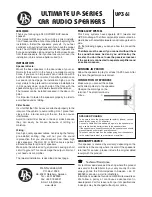
Sx300PI and Sx300PIX 300-
W
att T
w
o
-W
ay W
eather
-Resistant Speaker Systems
Sx300PI and Sx300PIX 300-Watt Two-Way Weather-Resistant Speaker Systems
2
Frequency Response
The combination of a 12-inch woofer, wide
bandwidth high-frequency driver and an
equalized crossover results in the wide and
smooth overall response shown in Figure 1.
This response was measured at 10 feet, us-
ing a 4-volt input in an anechoic chamber,
and was measured using a swept sine-wave
input. No external equalization was used.
Figure 1 has been averaged and corrected
for 1 watt at 1 meter.
Port Covers
The four ports surrounding the woofer may
be "sealed" in order to add further weather
protection to the system. Optional port cov-
ers may be used in situations where in-
creased weather resistance is needed. This
will aid in the prevention of any moisture
that may protrude through the foam-backed
grill under extreme weather conditions to
accumulate inside the enclosure. The op-
tional port cover "kit" is supplied along with
instructions with each system. However,
once the aid of the port covers are installed,
a difference of frequency response will
change as shown in Figure 2.
Constant-Directivity Speaker System
The crossover frequency and speaker com-
ponent geometries have been selected so that
the directional characteristics of the woofer
and constant-directivity horn match at the
crossover frequency to create a special sys-
tem type—the constant-directivity system.
Response within the 65° rated coverage
angle is uniform, which means dependable
audience coverage without “hot spots” or
dead zones at certain frequencies. The 65°
dispersion characteristic also helps avoid
early reflections from nearby floor or side-
wall surfaces which could degrade perfor-
mance. The controlled directivity of the
high- and low-frequency transducers also
eliminates response irregularities caused by
diffraction off nearby enclosure edges and,
in combination with an essentially flat on-
axis frequency response, produces a total acous-
tic power output that is uniform with frequency.
Directivity
A unique feature of the Sx300PI is the con-
stant-directivity dispersion provided by the
65° x 65° horn. The polar response of the
system at selected one-third-octave band-
widths is shown in Figure 2. These polar
responses were measured in an anechoic en-
vironment at 10 feet using one-third-octave
pink-noise inputs. The frequencies selected
are fully representative of the polar response
of the system. Beamwidth of the system uti-
lizing the complete one-third-octave polar
data is shown in Figure 4. R
q
and directiv-
ity index (D
i
) are plotted in Figure 5.
Suspending Sx300PI Enclosures
WARNING: Suspending any object is po-
tentially dangerous and should only be at-
tempted by individuals who have a thor-
ough knowledge of the techniques and
regulations of rigging objects overhead.
Electro-Voice strongly recommends that
the Sx300PI be suspended taking into ac-
count all current national, federal, state
and local regulations. It is the responsibil-
ity of the installer to ensure the Sx300PI is
safely installed in accordance with all such
regulations. If the Sx300PI is suspended,
Electro-Voice strongly recommends that
the system be inspected at least once a year.
If any sign of weakness or damage is de-
tected, remedial action should be taken im-
mediately.
When mounting the Sx300PI in a location
where a weather-resistant system is required,
a minimum of a five-degree down angle is
recommended. (See Figure 9.) This will aid
in the prevention of any moisture protrud-
ing through the foam-backed grille. A
manual entitled Suspending System 200
TM
Loudspeakers is included with every
Sx300PI system. It gives a summary of the
suspension kits available and an idea of how
each kit is used. A brief overview, which
illustrates some approaches for single and
multiple suspension, is given here for the
benefit of the system designer. Please refer
to individual suspension kit engineering data
sheets for full details and safety information.
The first approach is to suspend an indi-
vidual Sx300PI enclosure. The four metric
M8 x 1.25 inserts (see Figure 6) which are
built into the enclosure allow the system to
be suspended using eyebolts (Mb100 Ac-
cessory Kit). Typically it will be necessary
to attach two cables to the top eyebolt and
“pull up” on the rear. The Mb200 bracket
(see Figure 8) encompasses the top and bot-
tom of the enclosure and has additional fea-
tures to make suspending the Sx300PI easier
and more flexible. Electro-Voice recom-
mends the use of the Mb200 in all but the
simplest situations. The Mb200 has supple-
mentary holes to allow the Sx300PI to be
attached to a wall or ceiling and aimed at an
audience.
The Mb200 Installation Kit also allows the
use of OmniMount
®
Series 100 mounting
hardware by providing three-hole-pattern
groups compatible with these support sys-
tems. When OmniMount
®
Series 100
mounting hardware is specified, the Mb200
Installation Kit must first be attached to the
speaker enclosure.
The second approach is to suspend multiple
Sx300PI enclosures. The Sx300PI enclosure
is not designed to suspend multiple enclo-
sures from itself. If an “array” is required,
then multiple Mb200’s must be used. Ar-
rays may be constructed vertically by “daisy
chaining” two Mb200’s from each other.
The Mb300 array bracket allows the easy
and secure construction of horizontal arrays,
using Mb200’s to support the enclosure.
Power-Handling Capacity
To our knowledge, Electro-Voice was the
first U.S. manufacturer to develop and pub-
lish a power test closely related to real-life
conditions. First, we use a random-noise in-
put signal because it contains many frequen-
cies simultaneously, just like real voice or
instrument program. Second, our signal con-
tains more energy at extremely high and low
frequencies than typical actual program,
adding an extra measure of reliability. Third,
the test signal includes not only the overall
“long term average” or “continuous” level—
which our ears interpret as loudness—but
also short-duration peaks which are many
times higher than the average, just like ac-
tual program. The long-term average level
stresses the speaker thermally (heat). The
instantaneous peaks test mechanical reliabil-
ity (cone and diaphragm excursion). Note
that the sine-wave test signals sometimes
used have a much less demanding peak
value relative to their average level. In ac-
tual use, long-term average levels exist from
several seconds on up, but we apply the
long-term average for several hours, add-
ing another extra measure of reliability.
Specifically, the Sx300PI is designed to
withstand the power test described in the
ANSI/EIA RS-426-A 1980. The EIA test
spectrum is applied for eight hours. To ob-
tain the spectrum, the output of a white-noise
generator (white noise is a particular type


























